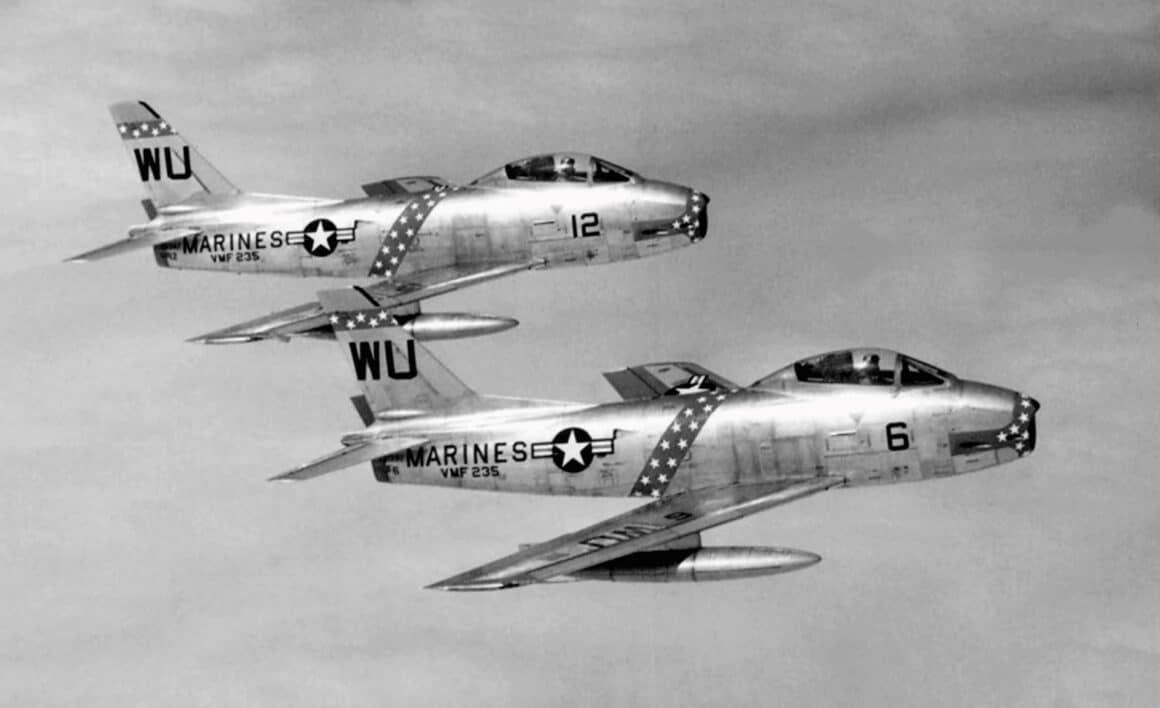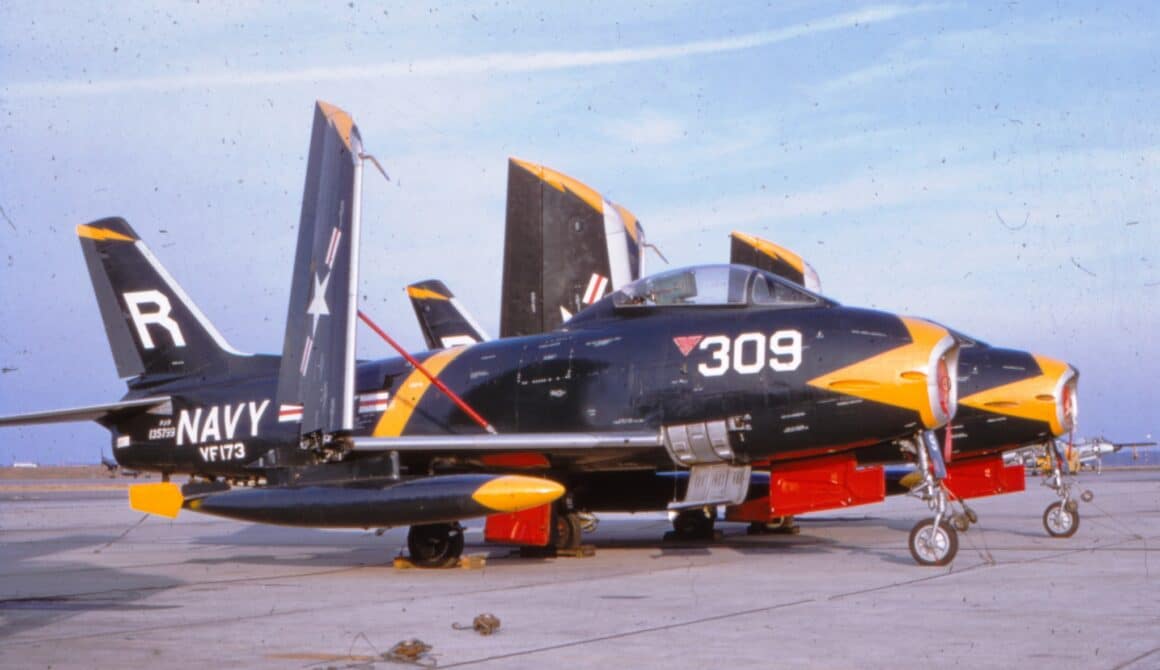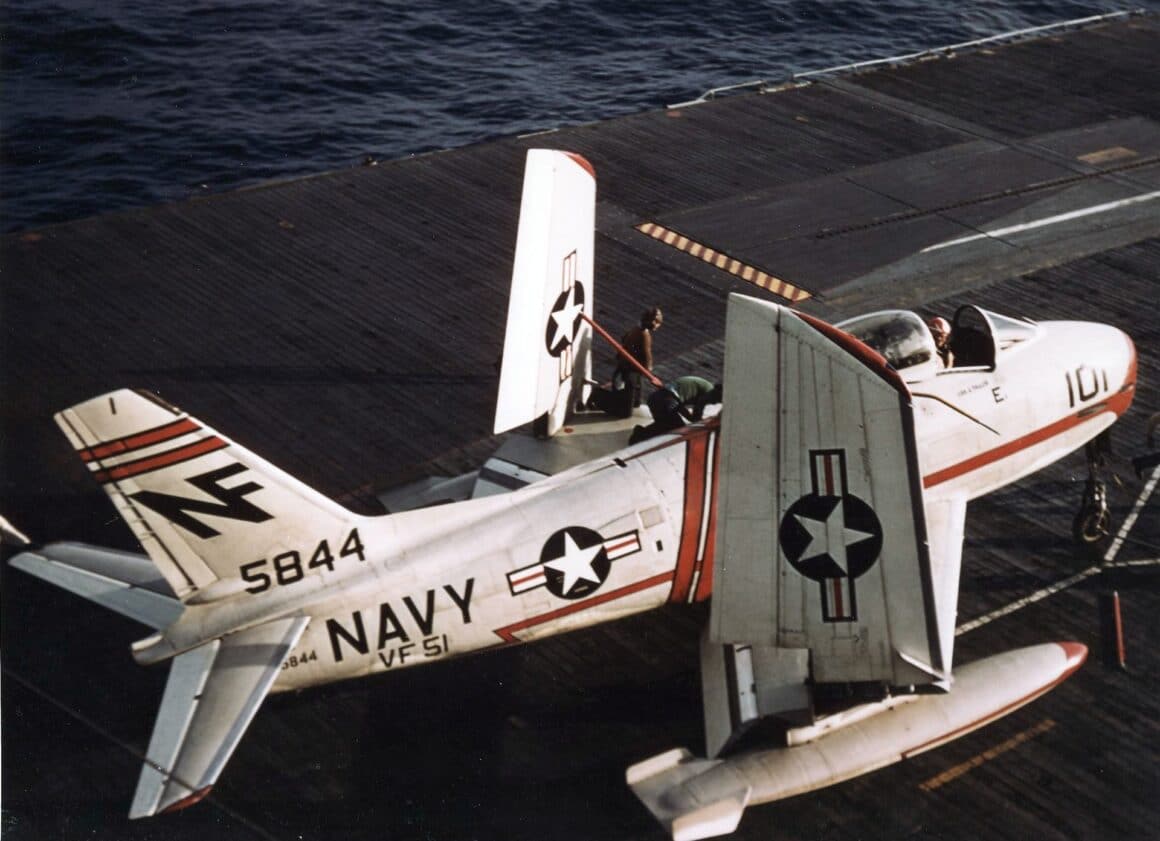Shortcomings Come Into Focus
VF-51 won the 1948 Bendix trophy with their Furies. But limiting factors of the FJ-1 included poor performance when flying fully loaded, lack of pressurization and temperature control in the cockpit, and the jet’s tips tanks had to be redesigned. VF-5A was redesignated VF-51 in August 1948. They only operated the FJ-1 until July of 1949, when they began flying the Grumman F9F-2 Panther. The FJ-1s went to the US Naval Reserve. The early Furies were all retired by the end of 1953.

Fury Spotting Guide
While the Navy was sorting out their few straight-wing Furies, the US Air Force had gone with swept wings for their F-86 Sabre. North American then decided to take the basic F-86 design and modify it for service with the Navy.
However, they didn’t change the name of the jet to comprehend the fact that the FJ-2, FJ-3, and FJ-4 Furies were all increasingly modified derivations of the hugely successful Air Force F-86- and very different compared to the FJ-1. The FJ-2 prototypes were essentially Air Force F-86Es with Navy paint.
Common to the FJ-2, FJ-3, and FJ-4 were folding wings, beefier landing gear with an extended nose gear strut, V-frame tailhooks, catapult bridle hooks, and four 20mm cannons in place of the six 50-caliber machine guns as internal gun armament.

Trials With Sabres
The FJ-2 Fury came about because in 1951, neither the swept-wing Grumman F9F Cougar nor the Vought F7U Cutlass was ready for prime time, and the Navy needed a counter to the swept-wing Mikoyan-Gurevich MiG-15. So the initial modifications to the F-86E were made, and renowned test pilot Bob Hoover flew the XFJ-2B for the first time on 27 December 1951.
Interestingly, the Navy actually ordered 300 FJ-2s even before the prototype flew for the first time. The order was later reduced to 200 production jets. In August 1952, carrier trials were flown aboard USS Midway (CVB-41) and aboard USS Coral Sea (CVB-43) between October and December 1952.

Finally a Navy Fighter
Bob Hoover flew the first production FJ-2 for the first time on 22 November 1952. Production FJ-2s were equipped with wider track landing gear, upward-folding outer wing panels, leading edge slats, all-flying horizontal stabilizers, a modified windscreen to provide better forward vision to the pilot during approach, and the -2 version of the same General Electric J47 axial-flow turbojet engine producing 6,000 pounds of thrust used in the F-86E.
The modifications for the FJ-2 increased the weight of the jet by about 1,100 pounds. For a first stab at a swept-wing carrier-based fighter, the FJ-2 wasn’t bad, but further refinements were needed. The 200 FJ-2s delivered by NAA ended up equipping six shore-based Marine Corps squadrons. The FJ-2s were retired from active duty Marine Corps squadrons by the end of 1956 and from Marine Corps Reserve units by the end of 1957.

Building a Better Fury
The next iteration of the Fury was the FJ-3. Other than their larger intakes (similar to those found on the F-86H variant of the Sabre), the FJ-3s were externally similar in appearance to the FJ-2s. But internally, the FJ-3 was powered by the Wright J65 axial-flow turbojet, producing 28% more thrust than the J47 at 7,700 pounds of thrust.
Initially, the FJ-3 wore FJ-2 wings, but later production jets had a nine-inch longer wing with the leading edge slats deleted and four underwing hardpoints for carriage of external ordnance or fuel tanks. Later FJ-3s had a refueling probe mounted under their port wings. The first production FJ-3 flew for the first time on 3 July 1953.

Still Not Quite All the Fury Could Be
In September 1954, VF-173 became the first Navy squadron to achieve active status with the FJ-3. Eventually, 23 Navy and Marine Corps squadrons operated the FJ-3. Because the FJ-3 had more thrust available, it handled better around the boat.
On 8 May 1955, the FJ-3 made its first carrier landings (and the first using the new mirror landing system) aboard the USS Bennington (CVA-20). Although the J65 engine wasn’t quite as suitable for flying from carriers from a reliability standpoint, the additional thrust provided made up for a lot.
NAA built 538 FJ-3s. The 194 FJ-3s modified to carry the AIM-9 Sidewinder missile were designated FJ-3M. FJ-3s modified to enable them to control SSM-N-8 Regulus guided missiles were designated FJ-3D. Those modified to direct Grumman F6F-5K drones and KDA targets were designated FJ-3D2. FJ-3s received refueling probes mounted under their left wings beginning in 1956.

